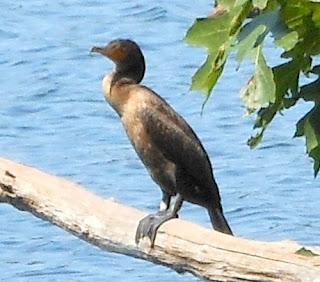Double-crested Cormorants and Mallards
Immature Double-crested Cormorant
While out walking around Lake Waban near Wellesley College, I was delighted to see several Double-crested Cormorants (Phalacrocorax auritus), including this family of adults and an immature bird. The immature bird is browner and palest on the neck and breast. The Mallards, all female, appear to be an adult with two young. It's likely they were born this past spring. While I wish the close up of the immature cormorant was clearer, keeping a respectful distance is paramount for this photographer.
In Massachusetts the Double-crested Cormorant is a summer resident. I had the pleasure of seeing one at Walden Pond in August. The Cornell Lab of Ornithology is an excellent source of information about this and many other birds. The following information is from Cornell, but I recommend visiting the link when you have a chance.
Double-crested Cormorants are the most widespread cormorant in North America, and the one most frequently seen in freshwater.
A cormorant’s diet is almost all fish, with just a few insects, crustaceans, or amphibians. They eat a wide variety of fish (more than 250 species have been reported), and they have impressive fishing technique: diving and chasing fish underwater with powerful propulsion from webbed feet. The tip of a cormorant’s upper bill is shaped like a hook, which is helpful for catching prey.
Double-crested cormorants are gregarious birds that are almost always near water. Their main two activities are fishing and resting, with more than half their day spent on the latter. When at rest, a cormorant will choose an exposed spot on a bare branch or a windblown rock, and often spread its wings out, which is thought to be a means of drying their feathers after fishing. (Cormorants have less preen oil than other birds, so their feathers can get soaked rather than shedding water like a duck’s. Though this sounds like a liability, this is thought to be an adaptation that helps cormorants hunt underwater more effectively.) When swimming atop the water, cormorants ride very low, and often only their long necks are evident.


No comments:
Post a Comment